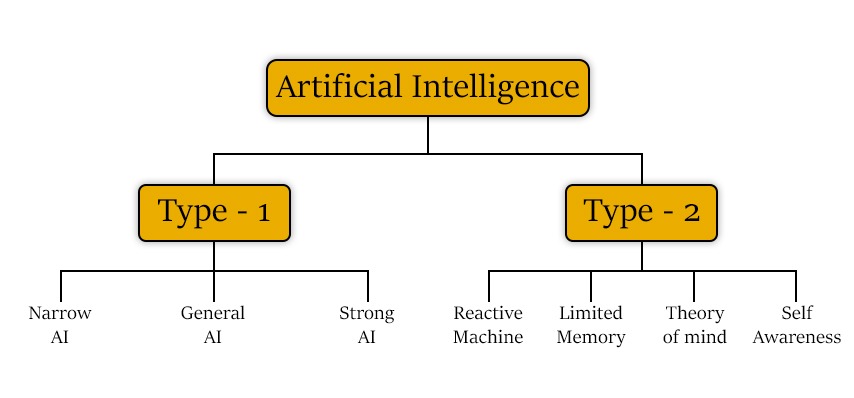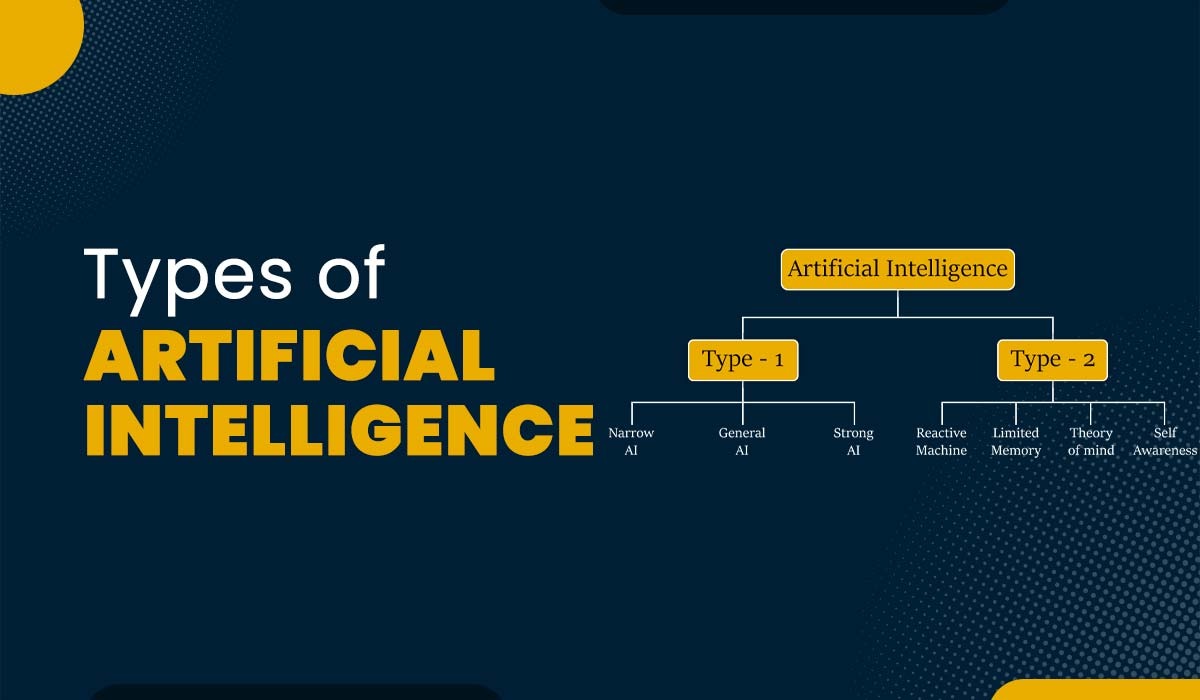Introduction
AI is helpful in completing tasks for which human Intelligence is needed, including learning and reasoning, problem-solving, perception, and understanding language. Thus, over the years, AI capabilities have been improving day by day. A clear understanding of different types of Artificial Intelligence is important to define it and see what it is capable of and what it is not capable of.
In this blog post, we will discuss different classifications of Artificial Intelligence along with examples. We will help you understand the types of AI according to its capabilities, i.e., narrow, general, and superintelligent AI, and second, according to the functions it can perform, i.e., the reactive machine, limited memory, theory of mind, and, finally, self-aware Intelligence. Last but not least, we will discuss some important technologies used in AI and their usage. To master the types of AI, we recommend AI and ML Course.
Here is a quick overview of the seven types of Artificial Intelligence:
- Artificial Narrow Intelligence (ANI)
- Artificial General Intelligence (AGI)
- Artificial Superintelligence (ASI)
- Reactive Machine AI
- Limited Memory AI
- Self-Aware AI
- Theory of Mind AI
Before getting into more details, let us first understand what AI is.
What is Artificial Intelligence?
Artificial Intelligence can be defined as the ability of a system to perform a certain task in a manner currently considered human-like. This means that machines can do things that require thinking the same as humans, including recognizing speech, understanding language, and deciding as well as solving problems. AI systems can process vast amounts of information within the shortest time possible, develop experiences, and adapt over time to perform better at their tasks.
Artificial Intelligence is literally everywhere, from intelligent personal assistants such as SIRI and ALEXA to the recommendation systems used by Netflix for making personalized recommendations to self-driving cars. As we know, these systems are intended to simplify our lives and to perform various operations.
AI can be categorized into different types based on their capabilities and functionalities. We can categorize AI in two primary ways: based on its capabilities and based on its functionalities.

Below, we have discussed both types of AI.
Types of Artificial Intelligence Based on Capabilities
Artificial Intelligence can be categorized based on capabilities into three main types. These are:
1. Artificial Narrow Intelligence (ANI)
Artificial Narrow AI, also known as Weak AI, is a class of AI that is created with specific objectives to achieve. ANI is good with specific niches but struggles with realizing how information from one task can be helpful with another. Most of the Artificial Intelligence that we come across today can be categorized under Artificial Narrow AI.
Examples of Narrow AI include:
- Virtual assistants like Siri and Alexa
- Recommendation algorithms on Netflix and Amazon
- Face recognition technologies
- Spam filters in email systems
- Chess and game-playing algorithms
Despite its limitations, ANI is highly effective for its designed tasks, making it invaluable in many industries, including finance, healthcare, and customer service.
2. Artificial General Intelligence (AGI)
Artificial General Intelligence, also known as Strong Artificial Intelligence, or Human-Level Artificial Intelligence. AGI is a kind of Intelligence that possesses adaptive features of knowledge acquisition and applying similar to a human’s. It’s reported that AGI will be able to think and solve any intellectual problem that humans can solve. Such problems include reasoning, problem-solving and even social interaction.
To date, AGI has remained theoretical. Currently, scientists and engineers are actively working on ways of creating such autonomic systems, but there are major problems, including a lack of understanding consciousness and the imitation of human cognition. These two problems have to be solved. If AGI is achieved, it could revolutionize industries, leading to innovations previously thought impossible.
3. Artificial Superintelligence (ASI)
Artificial superintelligence or super AI is still a subject of debate. While some believe it might be feasible to create super AI very soon, others insist that creation is way off and may involve momentous advancements in neuroscience, computer science, and mathematics.
The idea of artificial superintelligence is often seen in science fiction literature, which questions what an ASI would actually bring to humanity. Some assert that it could guide a technological singularity when exceptionally rapid and disruptive tech growth essentially changes human civilization. Others raise concerns regarding whether the ASI would be beyond their control and thus a potential existential threat to humanity. Therefore, it is important to fully consider the ethical and social implications and to take proactive measures to mitigate the potential dangers.
Types of Artificial Intelligence Based on Functionalities
Artificial Intelligence can be categorized based on functionalities into four main types. These are:
4. Reactive Machine AI
Reactive Machine AI represents the most basic type of Artificial Intelligence. These systems lack memory and the capability to learn from past experiences. Instead, they respond to specific inputs with set responses, functioning solely based on the current situation.
Examples of Reactive Machine AI include:
- IBM’s Deep Blue: This chess-playing computer could analyze numerous potential moves and their outcomes but was unable to remember past games or learn from them.
- Spam Filters: These systems can detect and filter spam emails using specific criteria but do not retain information from previous interactions or improve over time.
Reactive AI systems are effective for simple tasks that follow clear rules and conditions.
5. Limited Memory AI
Limited Memory AI represents an advancement over Reactive Machine AI. These systems are capable of learning from historical data and applying that knowledge to make informed decisions. By retaining some memory of past events, Limited Memory AI enhances its functionality over time.
Examples of Limited Memory AI include:
- Self-driving vehicles: These combine information from sensors with data already in the memory to determine which course of action to take in order to function properly and avoid obstacles. Self-driving vehicles improve their skills by learning from experiences.
- Chatbots: With regard to customer service, an interactive digital AI agent enters prior interactions by users, helping them respond a little more intelligently on the basis of conclusions gained from past sessions.
Limited Memory AI is important in applications that need a form of learning and should be adaptable.
6. Theory of Mind Artificial Intelligence
The Theory of Mind AI is still in its initiation stage, and it can represent a future stage of AI. Though we haven’t developed this type of AI completely, it needs machines that can recognize human emotions, beliefs, thoughts, and even their social interactions.
Potential Applications of Theory of Mind AI are:
- Social Robots: If AI machines can understand human emotions and intentions, then they can naturally interact with humans. Such robots would be able to offer support in some aspects of healthcare, education, or companionship.
- Personal Assistants: AI that knows the emotional state of a user may actually give more personalized feedback and support, which could be more productive in companion service.
This is what researchers are trying to achieve to get better interaction between humans and machines.
7. Self-Aware AI
It is the most progressive and hypothetical form of Artificial Intelligence, where accurate machines develop a conscious understanding of themselves. This brings machines into a state of having emotions, self-awareness, and perhaps their own thinking process.
Currently, there aren’t any self-aware AI systems, and it remains a matter of speculation among many researchers and thinkers.
These are 7 types of Artificial Intelligence present today in 2025. Let’s hope that we get to see more types of AI in 2025.
AI Technologies and its Applications
Artificial Intelligence has a wide range of capabilities and practical applications that are transforming various industries. Below, we have discussed some of the key technologies and their applications.
Expert Systems
Expert systems are computer software that is being developed for the purpose of solving a sophisticated, complicated problem that mimics the way a human expert makes a decision. These artificial intelligence (AI) systems employ information and inferential rules to learn how a piece of information can be represented and generate solutions or recommendations.
Practical Applications of Expert Systems are:
- Medical Diagnosis Systems: Such systems are able to quantify patient symptoms and provide patient diagnoses from a large database of medical knowledge.
- Financial Advisory Systems: Expert systems on the basis of Artificial Intelligence can be used to develop an evaluation of market conditions and to formulate investments on the basis of successful strategies already applied.
- Manufacturing and Production: Product design or quality assurance specialists are able to employ AI-based systems to help improve processes, predict maintenance requirements, and thereby improve general levels of operational efficiency.
Robotics
A robot is a machine able to act autonomously or with little human control. AI in robotics is applied to build up the performances of robots to be more efficient and flexible.
Some applications of robotics include:
- Manufacturing: In the factories, robots are able to carry out repetitive but accurate/fast operations, thus enhancing production efficiency.
- Healthcare: With the help of Surgical robots, it is now possible to perform surgeries with high precision. This will reduce the recovery time and improve patient outcomes.
- Exploration: Robots are highly preferred for exploration in harsh environments such as space and the deep sea.
Computer Vision
Computer vision is defined as the capacity of machines to process and comprehend vision from the environment. By means of image processing algorithms, the AI can process visual information such as photographs or videos and make decisions on the basis of this information.
Practical Applications of Computer Vision are:
- Facial Recognition: This feature is mostly used for security purposes. AI can assist in identifying individuals in images or videos. This same technology is widely used in smartphones/laptops in order to unlock devices and also in surveillance systems for inspecting public places.
- Medical Imaging: Systems with AI capabilities can also be utilized to analyze medical scans. This includes X-rays, MRIs, and CT scans. With this, doctors can be assisted in the fast diagnosing of diseases and with more accuracy.
Now, that we have seen types of Artificial Intelligence as well as its applications. Let’s see some questions related to it.
Frequently Asked Questions
Q1. What are the 4 types of artificial Intelligence?
Four types of artificial Intelligence based on functions are:
- Theory of Mind AI
- Self-Aware AI
- Limited Memory AI
- Reactive Machine AI
Q2. What are the 7 types of AI?
Seven types of AI are:
- Theory of Mind AI
- Self-Aware AI
- Limited Memory AI
- Reactive Machine AI
- Artificial Superintelligence (ASI)
- Artificial General Intelligence (AGI)
- Artificial Narrow Intelligence (ANI)
Q3. What is the scope of AI in Future?
The scope of AI is looking very bright in the future because of its potential application across various industries. It will also drive advancements in education, customer service, cybersecurity, and sustainability. As technology evolves, AI is expected to create new job opportunities while reshaping existing roles.
Q4. What are the advantages of AI?
Some of the advantages of Artificial Intelligence are:
- Automation of repetitive tasks
- Improved efficiency and accuracy
- Enhanced decision-making through data analysis
- Ability to handle complex problems
Q5. Is AI different from ML?
Yes, AI is different from ML. One of the most common difference between Artificial Intelligence and Machine Learning is that AI is something that can perform human tasks, while ML is a subset of AI that learns from data to improve AI’s performance.
Conclusion
Artificial Intelligence is a broad and complex field with many types and applications. Each type of Artificial Intelligence is used in a specific context based on the nature of the task because each brings factors of both strength and weakness. In order to understand the potential and limitations of AI, knowledge about various types of AI in terms of capabilities and functionalities must be known.
From narrow AI systems focused on a single performance task to theoretical ideas of superintelligence systems, AI is expanding further and further, and quite rapidly so.
The future of AI presents opportunities for advancements in different sectors and professionals who are on a continuous lookout to enhance their careers.





